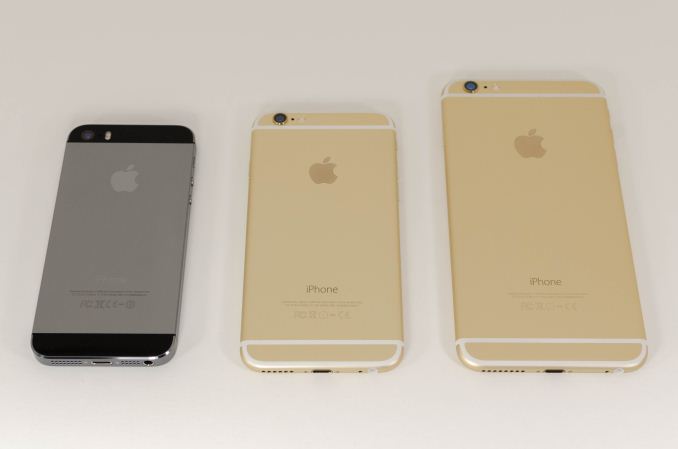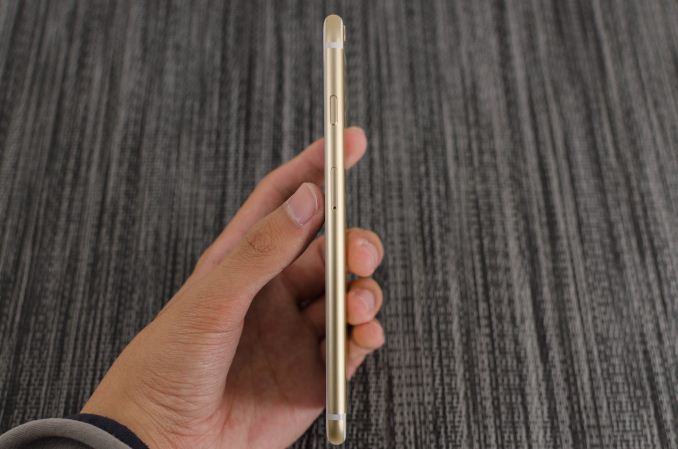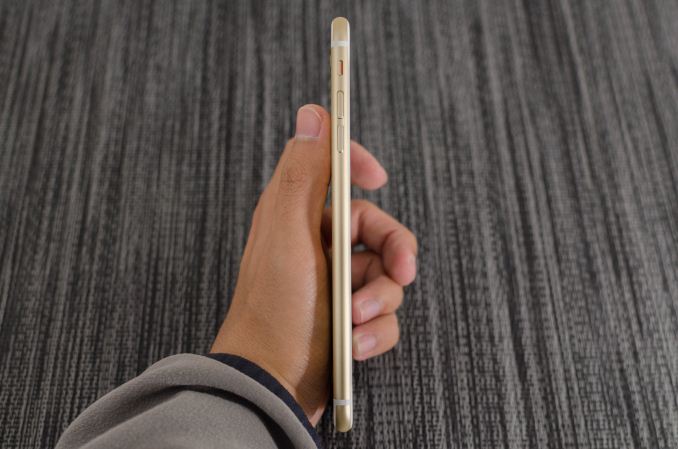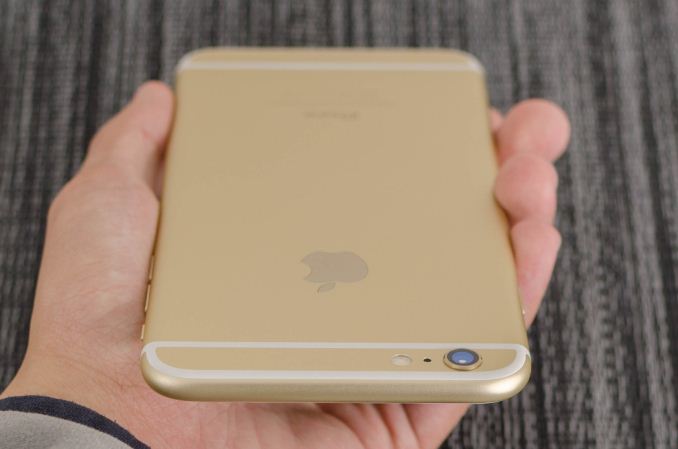The iPhone 6 Plus Mini-Review: Apple's First Phablet
by Joshua Ho on September 30, 2014 8:00 AM EST- Posted in
- Smartphones
- Apple
- Mobile
- iOS
- iPhone 6 Plus

While we’ve also written about the iPhone 6, the iPhone 6 Plus needs its own review in order to really understand the various features of the device that would otherwise be buried in the context of the iPhone 6. Without question, this device represents a significant departure from the way Apple has competed in the smartphone space. Until now, Apple hasn't competed in the phablet space and has thus avoided competing with Galaxy Note line that has been established as the dominant phablet for the past 3-4 generations. As a result, Apple occupies a fast-follower position at best.
This brings us to the iPhone 6 Plus, which really is an extension of the iPhone 6. Both phones share the same SoC, NAND configurations, front and rear camera sensors, LED flash module, industrial/material design, TouchID home button, earpiece and speaker configuration, WiFi/BT chipset, modem, and button layout. At this point, I’m going to stop listing similarities because the iPhone 6 Plus is interesting for its differences. Unlike similarities, the differences are simple. The iPhone 6 Plus is bigger, the display has higher pixel density, the camera has optical image stabilization, and iOS 8 has new app designs to take advantage of the larger screen. The iPhone 6 Plus is also more expensive, with the 16GB version starting at the same price as the 64GB version of the iPhone 6.
While I’ve already discussed the design of the iPhone 6, it’s important to see whether the same design translates to the iPhone 6 Plus. To this end, the iPhone 6 Plus does well. While the angular design of the iPhone 5 line would have looked and felt enormous in the hand, the shape is quite similar to the iPad line and is similarly comfortable in the hand, although the rounded edge really differentiates it, as does the control scheme. The only real issue here is that the top bezel on the front becomes surprisingly large, and this seems to contribute to a sense that the phone is top-heavy even though the phone is evenly balanced.
| Apple iPhone 5s | Apple iPhone 6 | Apple iPhone 6 Plus | |
| SoC | Apple A7 | Apple A8 | Apple A8 |
| Display | 4-inch 1136 x 640 LCD | 4.7-inch 1334 x 750 LCD | 5.5-inch 1920 x 1080 LCD |
| WiFi | 2.4/5GHz 802.11a/b/g/n, BT 4.0 | 2.4/5GHz 802.11a/b/g/n/ac, single stream, BT 4.0, NFC | |
| Storage | 16GB/32GB/64GB | 16GB/64GB/128GB | 16GB/64GB/128GB |
| I/O | Lightning connector, 3.5mm headset | ||
| Size / Mass |
123.8 x 58.6 x 7.6 mm, 112 grams |
138.1 x 67 x 6.9 mm, 129 grams |
158.1 x 77.8 x 7.1 mm, 172 grams |
| Camera |
8MP iSight with 1.5µm pixels Rear Facing + True Tone Flash 1.2MP f/2.4 Front Facing |
8MP iSight with 1.5µm pixels Rear Facing + True Tone Flash 1.2MP f/2.2 Front Facing |
8MP iSight with 1.5µm pixels Rear Facing + True Tone Flash + OIS 1.2MP f/2.2 Front Facing |
| Price |
$99 (16GB), $149 (32GB) on 2 year contract |
$199 (16GB), $299 (64GB), $399 (128GB) on 2 year contract |
$299 (16GB), $399 (64GB), $499 (128GB) on 2 year contract |
Overall, even though the iPhone 6 Plus is noticeably taller than the Galaxy Note 3 both feel similar in size. The iPhone 6 Plus is on the thinner side which makes a significant impression in the hand. At any rate, it’s physically impossible for me to use this device with one hand for most situations. It’s definitely a tablet in this sense, but in a much more compact and pocketable form factor.
"Bendgate"
Of course, drawing the comparison between the iPhone 6 Plus and Galaxy Note 3 inevitably raises the question of “bendgate”, which draws interesting parallels with “scuffgate” from the iPhone 5 generation. Unfortunately, I can’t destroy multiple review units in order to thoroughly investigate this issue. However, we can look at Consumer Reports’ data and come to a few conclusions about this problem. The first is that in the case of the iPhone 6 Plus, there appears to be an area near the bottom of the volume buttons that is a weak point as we see a clear failure of the casing in this area.
However, it seems that there is a significant amount of force needed in the first place in order to cause permanent deformation. Otherwise, everything that we’ve seen is primarily the result of fundamental differences between the two materials. It’s clear that in the case of the Galaxy Note 3 that a great deal of the structural rigidity is tied to the display itself, so the case doesn’t quite provide much in the way of protection as the polymer used is clearly in the elastic region all the way to failure. LG seems to have a different design though, as their polymer material has a clear case of brittle failure at the limit, which saved the display from shattering.
It's certainly possible to bend the iPhone 6 Plus (or really any phone or tablet), but the real issue here that hasn’t been addressed is the level of force needed to cause a certain level of elastic or plastic deformation in the material. This matters far more when discussing drop protection as the level of force in such a scenario is relatively small but applied over an extremely short period of time. There’s also no mention of force per unit area in any of these figures, so we can’t really have a serious discussion about this issue without the necessary data.














191 Comments
View All Comments
trynberg - Tuesday, September 30, 2014 - link
"They always make sure they come up with the first of its kind"????Hello, mainstream Android has had screens larger than 4" and phablets for 3 years. Many of the features in iOS 7 and iOS 8 were directly cribbed from Android. Apple has a nicely curated experience but give me a break.
trynberg - Tuesday, September 30, 2014 - link
No mention of any of the software bugs? No mention of apps not working properly with the new screen. A blanket assertion at the end of the review that says this is the best phablet with zero justification as to why this is better than a Note or G3?I would think Anandtech would work extra hard to make sure they are neutral towards Apple when your owner and another long term writer both left to work for Apple. This review doesn't come across as neutral.
There are legitimate criticisms of any phone, Android, WP, or Apple, and I didn't see any listed here.
cwolf78 - Tuesday, September 30, 2014 - link
Exactly. I've been slowly questioning the credibility of this site more and more. There was an obvious Apple bias when Anand and Brian were still here. I was hoping that would stop when they left. But I see more of the same. I'm not disputing that the iPhone 6 Plus is a great phone in its own right, but to say it's the best "phablet" on the market when it doesn't even have any demonstrable phablet capabilities? There's a lot more to a phablet than having a bigger screen. How about a stylus? Multi-window or split-screen support? Actual real multitasking? How about taking notes or sketching? How in the hell is this the best phablet on the market? You can't just claim something like that without backing it up and expect to be taken seriously.joe_dude - Wednesday, October 1, 2014 - link
There has been a slight pro-Apple bias ever since Anand started using Macs years ago. But it was never really an issue, since the testing was unbiased. Just ignore the pro-Apple conclusions, and it was all good. Glossing over problems is not what Anandtech is (or was) about.nerd1 - Wednesday, October 1, 2014 - link
Anand ALWAYS showed secret apple bias for years, by selecting which results to show etc (He always showed results that are favorable to apple devices). Take a look at the surface 3 pro review. He compares its IPS screen to macbook air's TN screen with TERRIBLE viewing angle and says SP3 has worse color accuracy than MBA.And now it just became more obvious so that anyone can notice. It's sad.
hlovatt - Wednesday, October 1, 2014 - link
You say the Anand review was biased against SP3 yet in the conclusions he says:"I was a fan of the original Surface Pro, and with Surface Pro 3 I think Microsoft has taken the hardware much closer to perfection."
Sounds like he likes it a lot to me. I take it that to you any criticism of the SP3, no matter how minor, is a sign of bias.
If you really want to see bias, I suggest you look no further than the nearest mirror.
nerd1 - Thursday, October 2, 2014 - link
SP3 is the best windows tablet devices ever, and he does not deny that. Yet it is just totally and absolutely absurd to compare SP3's 1440p IPS display to MBA's 900p TN display with terrible, terrible viewing angle. And he did, only showing test results favorable to MBA (like color accuracy when viewed DIRECTLY front of the screen)hlovatt - Thursday, October 2, 2014 - link
I think you see bias everywhere you look.He compared it to a number of devices: MBA, rMBP, and Air. The display of the SP3 came in better than MBA, but worse than the others, and that is what he said:
"Overall the Surface Pro 3 display is a huge improvement over the previous two generations, but it doesn't quite meet the high standards set by some of the other competitors on the market today from both notebook and tablet spaces."
I don't see bias in this, he just chose a number of broadly similar devices that lay from the cheaper MBA and Air to the slightly more rMBP, that seems fair and balanced to me.
GigaMonster - Thursday, October 2, 2014 - link
If you want to use a stylus with your iOS device, use a stylus. They're supported. WACOM makes a very nice 2048 one and plenty of apps make use of its multiple levels of sensitivity.instantchip - Tuesday, September 30, 2014 - link
In case you're conflicted about whether to get iPhone 6 or 6 Plus (like I was), try this quick decision tree to make your pick easier. It's on chipbrown(dot)me.It helped me decide--hope it helps you!